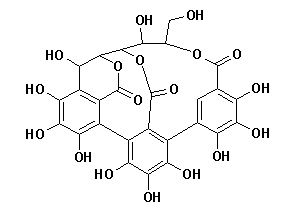Castalin
Castalin has antioxidant activity and yeast α-glucosidase inhibitory activity.
Inquire / Order:
manager@chemfaces.com
Technical Inquiries:
service@chemfaces.com
Tel:
+86-27-84237783
Fax:
+86-27-84254680
Address:
1 Building, No. 83, CheCheng Rd., Wuhan Economic and Technological Development Zone, Wuhan, Hubei 430056, PRC
Providing storage is as stated on the product vial and the vial is kept tightly sealed, the product can be stored for up to
24 months(2-8C).
Wherever possible, you should prepare and use solutions on the same day. However, if you need to make up stock solutions in advance, we recommend that you store the solution as aliquots in tightly sealed vials at -20C. Generally, these will be useable for up to two weeks. Before use, and prior to opening the vial we recommend that you allow your product to equilibrate to room temperature for at least 1 hour.
Need more advice on solubility, usage and handling? Please email to: service@chemfaces.com
The packaging of the product may have turned upside down during transportation, resulting in the natural compounds adhering to the neck or cap of the vial. take the vial out of its packaging and gently shake to let the compounds fall to the bottom of the vial. for liquid products, centrifuge at 200-500 RPM to gather the liquid at the bottom of the vial. try to avoid loss or contamination during handling.
Vojnosanit Pregl2016, 75(00):391-391
Eur Rev Med Pharmacol Sci.2020, 24(9):5127-5139.
Microb Biotechnol.2021, 14(5):2009-2024.
Biomolecules.2020, 10(6):925.
Hum Exp Toxicol.2023, 42:9603271221145386.
Tokyo Pharmaceutical University2020, 500001431953.
Biomed Pharmacother.2020, 131:110673.
Pharmaceutics.2023, 15(9):2355.
Chem Pharm Bull (Tokyo).2017, 65(9):826-832
BMC Complement Altern Med.2014, 14:242
Related and Featured Products
Food Chemistry, 2017, 215:50-60.
α-Glucosidase inhibition and antioxidant activity of an oenological commercial tannin. Extraction, fractionation and analysis by HPLC/ESI-MS/MS and 1H NMR.[Reference:
WebLink]
METHODS AND RESULTS:
Two batches of the oenological tannin Tan’Activ R, (toasted oak wood – Quercus robur), were extracted with ethanol.
A fractionation on XAD-16 afforded four fractions for each extract. Extracts and fractions were evaluated for antioxidant activity (DPPH), polyphenol content (GAE) and yeast α-glucosidase inhibitory activity.
CONCLUSIONS:
Comparable results were obtained for both columns, fractions X1B and X2B showing the highest antioxidant activity. Fractions X1C and X2C notably inhibited α-glucosidase, with IC50 = 9.89 and 8.05 μg/mL, respectively. Fractions were subjected to HPLC/ESI-MS/MS and 1H NMR analysis. The main phenolic constituents of both X1B and X2B were a monogalloylglucose isomer (1), a HHDP-glucose isomer (2), Castalin (3) gallic acid (4), vescalagin (5), and grandinin (or its isomer roburin E, 6). X1C and X2C showed a complex composition, including non-phenolic constituents. Fractionation of X2C gave a subfraction, with enhanced α-glucosidase inhibitory activity (IC50 = 6.15 μg/mL), with castalagin (7) as the main constituent.
Food chemistry., 12 Feb 2014, 157:290-295
Tannin analysis of chestnut bark samples (Castanea sativa Mill.) by HPLC-DAD-MS.[Reference:
WebLink]
METHODS AND RESULTS:
In the present investigation, an HPLC-DAD/ESI-MS method for the complete analysis of tannins and other phenolic compounds of different commercial chestnut bark samples was developed. A total of seven compounds (vescalin, Castalin, gallic acid, vescalagin, 1-O-galloyl castalagin, castalagin and ellagic acid) were separated and quantified, being 1-O-galloyl castalagin tentatively identified and found for the first time in chestnut bark samples.
CONCLUSIONS:
Thus, this method provided information regarding the composition and quality of chestnut bark samples, which is required since these samples are commercialised due to their biochemical properties as ingredients of food supplements.



